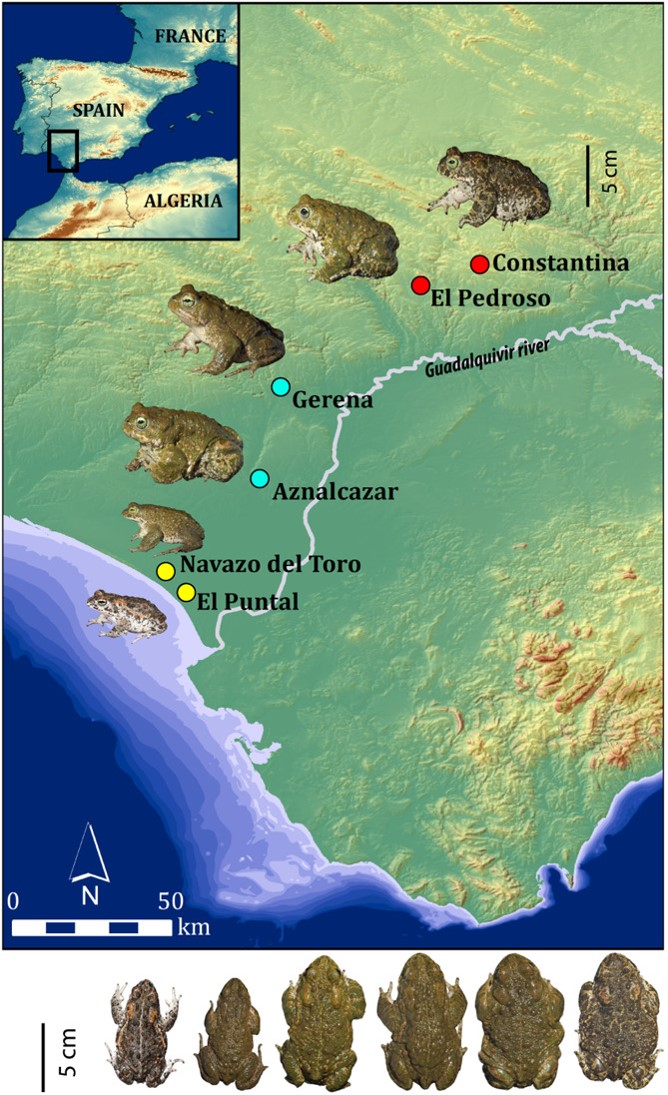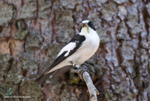Ample variation in body size is common in vertebrates over extensive geographical distances, or in isolated populations, where effective geographical barriers may cause dwarfism or gigantism. The potential causes of extreme size reduction in continental populations of amphibians within a short geographical distance and in the absence of geographical barriers were studied. Natterjack toads Epidalea calamita in Doñana National Park (Spain) experience up to 2.1?fold difference in body mass in as little as 37?km. Studying six populations divergent in body size, the genetic isolation of the dwarf populations using multilocus genotypes (16 microsatellites) was tested. Additionally, it was explored whether populations differed in trophic status (through stable isotope analysis), standard metabolic rate and growth pattern, senescence and age structure (conducting telomere length assays and skeletochronology). Advertisement calls were also recorded across populations and experimentally tested for behavioural reinforcement of the body size variation through female preferences. Local dwarfism in these populations occurs in the absence of genetic isolation while maintaining relatively high effective population sizes. Dwarf populations, however, were exposed to drier and warmer climatic conditions, have different trophic status, show lower mass?specific metabolic rate, and male advertisement calls with a higher dominant frequency. Juvenile growth differed among populations, reaching the adult stage at different body sizes. Altogether, these results suggest a significant influence of environmental conditions on the physiology and ecology of the Doñana E. calamita populations, mainly affecting toads between metamorphosis and sexual maturity. Further experimental and genomic studies focusing on these early life stages are necessary to dissect the relative roles of the environment and adaptive genetic differentiation on this phenomenon. informacion[at]ebd.csci.es: Hyeun-Ji et al (2020) Dwarfism in close continental amphibian populations despite lack of genetic isolation. OIKOS Doi 10.1111/oik.07086
https://onlinelibrary.wiley.com/doi/full/10.1111/oik.07086Content with tag body size .
 Dwarfism in continental populations of natterjack toads in the absence of genetic isolation
Dwarfism in continental populations of natterjack toads in the absence of genetic isolation
Ample variation in body size is common in vertebrates over extensive geographical distances, or in isolated populations, where effective geographical barriers may cause dwarfism or gigantism. The...
 Larger brain size entails a greater risk of extinction in mammals
Larger brain size entails a greater risk of extinction in mammals
How brain size directly and indirectly influences vulnerability to extinction across 474 mammalian species was evaluated. Under current conditions, the constraints on life-history imposed by large...
 The effect of body size and habitat on the evolution of alarm vocalizations in rodents
The effect of body size and habitat on the evolution of alarm vocalizations in rodents
When confronted with a predator, many mammalian species emit vocalizations known as alarm calls. Vocal structure variation results from the interactive effects of different selective pressures....
 Mirror, mirror! Where should I settle?
Mirror, mirror! Where should I settle?
The matching habitat choice hypothesis holds that individuals with different phenotypes select the habitats to which they are best adapted to maximize fitness. Despite the potential implications of...






